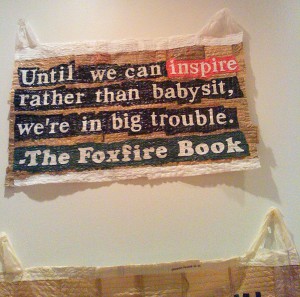Looking at contemporary art can sometimes be like going to a movie and saying, “what did we just see?’

Confusing. And frustrating.
Did the filmmaker just not give enough information or is it me? And we can feel the same way about art, but more easily assume it’s us. It’s our own lack of ability to get it. Or, is it because there is so little context available to us to make a good interpretation? If you search for information about a film, there are reviews and comments and IMDB.
You can often get more information about artists, like Kiki Smith, online. But when you stumble into a gallery and see a show, all you have to go on is what’s physically there: a brochure, notes on the wall big and small.
So when I walked through the steel doors that feel like a meat locker entrance into the Block Gallery on the Northwestern University campus, I was hit with four poster-like tapestries conveying wise mottos. And the notes on the wall.
Big was ‘Temporary Services.’ Smaller were words explaining that there were four projects. I looked left and saw some nicely crafted fiber art. I looked right and saw of bigger gallery with photographs and a sign that said ‘Kiki Smith,’ and I had been handed a card from this ‘Kiki Smith’ show when I walked in the building entrance. I also happen to know that Kiki Smith is an artist and the daughter of Tony Smith, have seen some of her sculpture and her fathers.

I read the big and smaller words again and figure out that Temporary Services is not an company that provided museum staff on the weekend when the regular staff was off.
It is also not what they do with this wall when they can’t think of anything else; Temporary Services is the name of a team of artists. And this team uses other people to produce conceptual works. These four projects are examples. So I read again what each of these projects are and try to figure out if they are the four mottos on the wall. The mottos are tapestries made of plastic, and I finally guess that they are the project called Personal Plastic: and made from ubiquitous (a word that is ubiquitous in 2011) plastic grocery bags.
The mottos – “Until we can inspire rather than babysit, we’re in big trouble” is from the Foxfire book. And I search my memory for such a book. Yes, it was a ‘getting back to nature book’ from the ’60s or ’70s, back when solar energy was a great idea, and so was making things out of previously used materials, and recycling and eating food that has real nutrition and not chemical nutrition fabricated at Proctor & Gambles.
Okay, so great. These guys probably make some cool stuff. And I wonder over to look at the nice weavings or whatever you call these fiber pieces, and wonder why they seem so much less conceptual than the Personal Plastic project.

Surprise …. tucked behind this wall is a laboratory with a glass door inviting me to look in. And there are the names of one the other three projects in big letter boldly stuck on the wall.
4. Self-Reliant Library. This project is shelves of the Foxfire Book and more helpful books like it. This is an autonomous reading and creating library, the docent tells me.
Self reliance library is interesting, and a little nostalgic, to browse and includes all the Foxfire books, geodesic dome books, things that have interested people 40 years ago and have come back into vogue. (in this era people were fascinated by …. mesmerism, in this era people were fascinated by Indian spices….always something.)
The others on the list of project were:
1. Free for All which was essentially a box where people could put stuff. The artists’ collective (Temp. Services) suggested that there was enough literature from this show to make one’s own box.

2. Personal Plastic (which was out front)
3. Designated Drivers: a wall of jump drives.
Docent is required. One computer, which this docent operated, made for communal viewing as the docent told us all about the various drives. They took a long time to load and were mostly video or pictures. This is more like flipping through a magazine in a doctors office, when you’re nervous, uncomfortable, possible sick and impatient. I’m sure there was some good stuff in there, but I wasn’t going to find it.
And so we finally go out again, past the weavings, and see the Kiki Smith work.
Kiki Smith (first picture, just to make it similarly confusing): put together lots of ways of looking at things people turn their heads away from. Looking so many ways that something might show up. Trying to find something in these images to look at. You’ll get a handle on it, if you collect every single one: worms, crows, squirrels.
Did this have to be so confusing? I wondered.
My friend said, “They should have just put a big arrow on the wall, and told us to go around.”
That’s just so un-museum like. It would be too clear.

